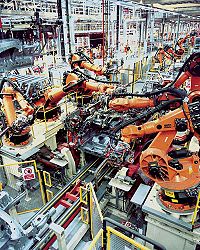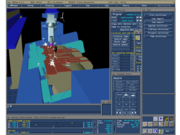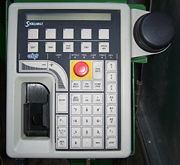
Typical applications of robots include welding, painting, ironing, assembly, pick and place, packaging and palletizing, product inspection, and testing, all accomplished with high endurance, speed, and precision.
The most commonly used robot configurations are articulated robots, SCARA robots and gantry robots (aka Cartesian Coordinate robots, or x-y-z robots). In the context of general robotics, most types of robots would fall into the category of robot arms (inherent in the use of the word manipulator in the above-mentioned ISO standard). Robots exhibit varying degrees of autonomy:
- Some robots are programmed to faithfully carry out specific actions over and over again (repetitive actions) without variation and with a high degree of accuracy. These actions are determined by programmed routines that specify the direction, acceleration, velocity, deceleration, and distance of a series of coordinated motions.
- Other robots are much more flexible as to the orientation of the object on which they are operating or even the task that has to be performed on the object itself, which the robot may even need to identify. For example, for more precise guidance, robots often contain machine vision sub-systems acting as their "eyes", linked to powerful computers or controllers. Artificial intelligence, or what passes for it, is becoming an increasingly important factor in the modern industrial robot.
History of Industrial Robotics in the Work Force
George Devol applied for the first robotics patents in 1954 (granted in 1961). The first company to produce a robot was Unimation, founded by George Devol and Joseph F. Engelberger in 1956, and was based on Devol's original patents. Unimation robots were also called programmable transfer machines since their main use at first was to transfer objects from one point to another, less than a dozen feet or so apart. They used hydraulic actuators and were programmed in joint coordinates, i.e. the angles of the various joints were stored during a teaching phase and replayed in operation. They were accurate to within 1/10,000 of an inch (note: although accuracy is not an appropriate measure for robots, usually evaluated in terms of repeatability - see later). Unimation later licensed their technology to Kawasaki Heavy Industries and Guest-Nettlefolds, manufacturing Unimates in Japan and England respectively. For some time Unimation's only competitor was Cincinnati Milacron Inc. of Ohio. This changed radically in the late 1970s when several big Japanese conglomerates began producing similar industrial robots.
In 1969 Victor Scheinman at Stanford University invented the Stanford arm, an all-electric, 6-axis articulated robot designed to permit an arm solution. This allowed it to accurately follow arbitrary paths in space and widened the potential use of the robot to more sophisticated applications such as assembly and welding. Scheinman then designed a second arm for the MIT AI Lab, called the "MIT arm." Scheinman, after receiving a fellowship from Unimation to develop his designs, sold those designs to Unimation who further developed them with support from General Motors and later marketed it as the Programmable Universal Machine for Assembly (PUMA). In 1973 KUKA Robotics built its first robot, known as FAMULUS, this is the first articulated robot to have six electromechanically driven axes.
Interest in robotics swelled in the late 1970s and many US companies entered the field, including large firms like General Electric, and General Motors (which formed joint venture FANUC Robotics with FANUC LTD of Japan). U.S. start-ups included Automatix and Adept Technology, Inc. At the height of the robot boom in 1984, Unimation was acquired by Westinghouse Electric Corporation for 107 million U.S. dollars. Westinghouse sold Unimation to Stäubli Faverges SCA of France in 1988, which is still making articulated robots for general industrial and clean room applications and even bought the robotic division of Bosch in late 2004.
Only a few non-Japanese companies ultimately managed to survive in this market, including Adept Technology, Stäubli-Unimation, the Swedish-Swiss company ABB (ASEA Brown-Boveri), the Austrian manufacturer igm Robotersysteme AG and the German company KUKA Robotics.
- Number of axes two axes are required to reach any point in a plane; three axes are required to reach any point in space. To fully control the orientation of the end of the arm (i.e. the wrist) three more axes (roll, pitch and yaw) are required. Some designs (e.g. the SCARA robot) trade limitations in motion possibilities for cost, speed, and accuracy.
- Degrees of freedom which is usually the same as the number of axes.
- Working envelope the region of space a robot can reach.
- Kinematics the actual arrangement of rigid members and joints in the robot, which determines the robot's possible motions. Classes of robot kinematics include articulated, cartesian, parallel and SCARA.
- Carrying capacity or payload how much weight a robot can lift.
- Speed how fast the robot can position the end of its arm. This may be defined in terms of the angular or linear speed of each axis or as a compound speed i.e. the speed of the end of the arm when all axes are moving.
- Acceleration - how quickly an axis can accelerate. Since this is a limiting factor a robot may not be able to reach it's specified maximum speed for movements over a short distance or a complex path requiring frequent changes of direction.
- Accuracy how closely a robot can reach a commanded position. Accuracy can vary with speed and position within the working envelope and with payload (see compliance). It can be improved by Robot calibration.
- Repeatability - how well the robot will return to a programmed position. This is not the same as accuracy. It may be that when told to go to a certain X-Y-Z position that it gets only to within 1 mm of that position. This would be its accuracy which may be improved by calibration. But if that position is taught into controller memory and each time it is sent there it returns to within 0.1 mm of the taught position then the repeatability will be within 0.1 mm.
- Motion control for some applications, such as simple pick-and-place assembly, the robot need merely return repeatably to a limited number of pre-taught positions. For more sophisticated applications, such as welding and finishing (spray painting), motion must be continuously controlled to follow a path in space, with controlled orientation and velocity.
- Power source some robots use electric motors, others use hydraulic actuators. The former are faster, the latter are stronger and advantageous in applications such as spray painting, where a spark could set off an explosion; however, low internal air-pressurisation of the arm can prevent ingress of flammable vapours as well as other contaminants.
- Drive some robots connect electric motors to the joints via gears; others connect the motor to the joint directly (direct drive). Using gears results in measurable 'backlash' which is free movement in an axis. In smaller robot arms with DC electric motors, because DC motors are high speed low torque motors they frequently require high ratios so that backlash is a problem. In such cases the harmonic drive is often used.
- Compliance - this is a measure of the amount in angle or distance that a robot axis will move when a force is applied to it. Because of compliance when a robot goes to a position carrying it's maximum payload it will be at a position slightly lower than when it is carrying no payload. Compliance can also be responsible for overshoot when carrying high payloads in which case acceleration would need to be reduced.
Robot programming and interfaces


The setup or programming of motions and sequences for an industrial robot is typically taught by linking the robot controller to a laptop, desktop computer or (internal or Internet) network.
Software: The computer is installed with corresponding interface software. The use of a computer greatly simplifies the programming process. Specialized robot software is run either in the robot controller or in the computer or both depending on the system design.
Teach pendant: Robots can also be taught via a teach pendant; a handheld control and programming unit. The common features of such units are the ability to manually send the robot to a desired position, or "inch" or "jog" to adjust a position. They also have a means to change the speed since a low speed is usually required for careful positioning, or while test-running through a new or modified routine. A large emergency stop button is usually included as well. Typically once the robot has been programmed there is no more use for the teach pendant.
Lead-by-the-nose is a technique offered by most robot manufacturers but is of dubious value. While user holds the robot end effector another person enters a command which de-energizes the robot and it goes limp. The user then moves the robot by hand to the required positions or along a required path while the software logs these positions into memory. The program can later run the robot to these positions or along the taught path. This technique is popular for tasks such as paint spraying.
Others In addition, machine operators often use human machine interface devices, typically touch screen units, which serve as the operator control panel. The operator can switch from program to program, make adjustments within a program and also operate a host of peripheral devices that may be integrated within the same robotic system. These include end effectors, feeders that supply components to the robot, conveyor belts, emergency stop controls, machine vision systems, safety interlock systems, bar code printers and an almost infinite array of other industrial devices which are accessed and controlled via the operator control panel.
The teach pendant or PC is usually disconnected after programming and the robot then runs on the program that has been installed in its controller. However a computer is often used to 'supervise' the robot and any peripherals, or to provide additional storage for access to numerous complex paths and routines.
A robot and a collection of machines or peripherals is referred to as a workcell, or cell. A typical cell might contain a parts feeder, a molding machine and a robot. The various machines are 'integrated' and controlled by a single computer or PLC.
Recent and future developments
As of 2005, the robotic arm business is approaching a mature state, where they can provide enough speed, accuracy and ease of use for most of the applications. Vision guidance (aka machine vision) is bringing a lot of flexibility to robotic cells. So we have the arm and the eye, but the part that still has poor flexibility is the hand: the end effector attached to a robot is often a simple pneumatic, 2-position wrench. This doesn't allow the robotic cell to easily handle different parts, in different orientations.
Hand-in-hand with increasing off-line programmed applications, robot calibration is becoming more and more important in order to guarantee a good positioning accuracy.
Other developments include downsizing industrial arms for consumer applications (micro-robotic arms), manufacture of domestic robots and using industrial arms in combination with more intelligent automated guided vehicles (AGVs) to make the automation chain more flexible between pick-up and drop-off.
Prices of robots will vary with the features, but are usually from 12,000 USD for an entry-level model, and as much as 100,000 or more for a heavy-duty, long-reach robot.
- ISO Standard 8373:1994, Manipulating Industrial Robots Vocabulary
- Nof, Shimon Y. (editor) (1999).
Handbook of Industrial Robotics, 2nd ed.
John Wiley & Sons. 1378 pp.
A comprehensive reference on the categories and applications of industrial robotics.
